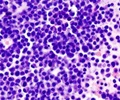Scientists have developed a unique therapeutic strategy, using genetic information initially uncovered in fruit fly studies, that stops an aggressive and deadly form of leukemia in laboratory models of the disease.

"Using ancient and evolutionarily conserved molecular pathways, we demonstrate for the first time in mice transplanted with human AML the therapeutic potential of targeting microRNAs to significantly improve current therapies," said H. Leighton Grimes, PhD, senior investigator and a researcher in the divisions of Immunobiology and Experimental Hematology/Cancer Biology at Cincinnati Children's. "This work provides a proof of principle that moves forward the concept of RNA therapies capable of blocking microRNAs that trigger relapsed AML."
About 70 percent of people with AML respond initially to standard chemotherapy. Unfortunately, five-year survival rates vary between 15-70 percent, depending on the subtype of AML.
Grimes and his research colleagues are aiming for a new therapeutic approach that could augment existing treatments. An important goal is helping increase the number of patients with aggressive and relapsed AML who are eligible for a bone marrow transplant. At present, bone marrow transplant is the only curative therapy for relapsed AML, but many patients do not respond well enough to chemotherapy to have the procedure.
In mouse models of AML and in relapsed human AML, scientists and clinicians are concerned about so-called leukemia-initiating cells. These initiating cells are a subset of human AML cells capable of taking hold after being transplanted into mouse models of the disease. Similarly, it is suspected that a subset of human AML cells in patients can reinitiate disease if chemotherapy does not eliminate all of the leukemic cells. When this occurs, these cancer stem cells are thought to be responsible for relapse in people with AML.
In their study, the authors tested a particularly aggressive, high-relapse form of AML driven by what are called homeobox or Hox genes. Cancer proteins fueled by HOX genes (in particular one called HoxA9, which can be traced back to Drosophila fruit flies) result in an AML subtype with very poor prognosis for people.
Advertisement
The scientists then extended this concept to uncover a similar fight between HoxA9 and Gfi1 in controlling the transformation of mammalian blood cells by leukemia-causing proteins. It was known prior to this study that HoxA9 plays an important role in transforming cells to become leukemic, but Grimes and his colleagues discovered that Gfi1 is able to cancel this effect. The researchers believe Gfi1 does this by repressing key target genes that HoxA9 must activate to continue the leukemia process.
Advertisement
To therapeutically translate the effect of Gfi1 repressing microRNAs targeted by HoxA9, the scientists blocked miR-21 and -196b – and their production of leukemia initiating cells – by using short synthetic strands of RNA called antagomirs. The structure of antagomirs allows them to block the function of specific microRNAs inside a living organism, like a mouse.
Grimes and his colleagues tested the antagomirs in several different experiments involving AML cells and in mouse models of AML. The experiments showed the antagomirs stopped the growth of leukemia cells. This included a typically fatal form of multi-lineage leukemia caused by an abnormal rearrangement of chromosomes (called chromosomal translocations) involving the human chromosome band 11q23. Researchers report antagomir therapy eliminated these leukemia cells.
In one test, the scientists treated humanized mouse models (transplanted with human 11q23-translocation leukemia) with a combination of antagomirs that block miR-21 and miR-196b and chemotherapy. Mice treated with either chemotherapy alone or chemotherapy with control antagomir therapy died on average in about 62 days. Mice treated with chemotherapy and miR-21 and miR-196b-specific antagomirs saw their survival extend significantly to an average of about 80 days.
The researchers emphasized that significant additional study is required before extending their findings to the treatment of human leukemia patients.
Source-Eurekalert











